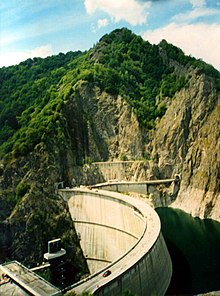Vidraru Dam
| Vidraru Dam | |
|---|---|

The Vidraru dam
|
|
| Location |
Argeş River, Argeş County Romania |
| Coordinates | 45°21′58.5″N 24°37′47.28″E / 45.366250°N 24.6298000°ECoordinates: 45°21′58.5″N 24°37′47.28″E / 45.366250°N 24.6298000°E |
| Construction began | 1960 |
| Opening date | 1966 |
| Dam and spillways | |
| Impounds | Argeş River |
| Height | 166 m (545 ft) |
| Length | 305 m (1,001 ft) |
| Dam volume | 480,000 m3 (630,000 cu yd) |
| Reservoir | |
| Creates | Lake Vidraru |
| Total capacity | 0.465 km3 (0.112 cu mi) |
| Catchment area | 286 km2 (110 sq mi) |
| Surface area | 10 km2 (3.9 sq mi) |
| Power station | |
| Commission date | 9 December 1966 |
| Turbines | 4 x 55 MW Francis-type |
| Installed capacity | 220 MW |
| Annual generation | 400 GWh |
Vidraru Dam is a dam in Romania. It was completed in 1966 on the Argeş River and creates Lake Vidraru. The arch dam was built with the primary purpose to produce hydroelectricity. The dam's height is 166 metres, the arch length 305 meters and it can store 465 million cubic metres of water. The reservoir has a total shoreline (perimeter) length of 28 km.
Situated between Frunţii Mountains and Ghiţu mountains, the lake collects the Capra, Buda and some other smaller rivers (Râul Doamnei, Cernatu and Vâlsan, Topolog, Valea lui Stan and Limpedea), with a total flow of about 5.5 million l /s. The total surface of the lake is 3,930,000 sq m, 10.3 km in length, with a maximum width of 2.2 km in the Valea Lupului zone - Călugăriţa. Normal level or water retention is 830.00 metres above sea level (mdM). This amazing structure is also built with a lot of safety features. For example, if the dam cracked, got bombed or broke all of the water would flood a lot of cities. Therefore, for safety reasons dynamite has been placed in the mountains so if something happens to the dam and it breaks, the workers detonate the dynamite and make a natural dam out of the rocks in the mountains holding the water back.
The dam's construction took 5 and a half years. It required 42 km of subterranean tunnels, excavation of 1,768,000 cubic metres of hard rocks, out of which approximatively 1 million had to be extracted from underground, 930,000 cubic metres of concrete, out of which 400,000 cubic metres were underground and required the installation of 6,300 tons of electro-mechanical equipment.
When completed, it ranked 5th in Europe, and 9th in the world. In an average hydrological year it can generate approximately of 400 GWh/year.
The Vidraru Hydro Power Plant has an installed capacity of 220 MW.
...
Wikipedia
